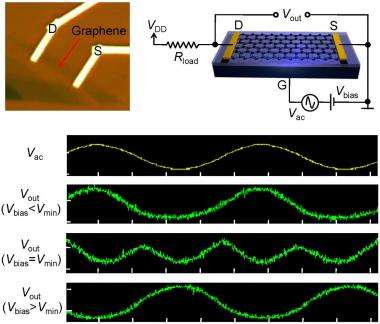Triple-mode transistors show potential: Researchers introduce graphene-based amplifiers

(PhysOrg.com) -- Rice University research that capitalizes on the wide-ranging capabilities of graphene could lead to circuit applications that are far more compact and versatile than what is now feasible with silicon-based technologies.
Triple-mode, single-transistor amplifiers based on graphene -- the one-atom-thick form of carbon that recently won its discoverers a Nobel Prize -- could become key components in future electronic circuits. The discovery by Rice researchers was reported this week in the online journal ACS Nano.
Graphene is very strong, nearly transparent and conducts electricity very well. But another key property is ambipolarity, graphene's ability to switch between using positive and negative carriers on the fly depending on the input signal. Traditional silicon transistors usually use one or the other type of carrier, which is determined during fabrication.
A three-terminal single-transistor amplifier made of graphene can be changed during operation to any of three modes at any time using carriers that are positive, negative or both, providing opportunities that are not possible with traditional single-transistor architectures, said Kartik Mohanram, an assistant professor of electrical and computer engineering at Rice. He collaborated on the research with Alexander Balandin, a professor of electrical engineering at the University of California, Riverside, and their students Xuebei Yang (at Rice) and Guanxiong Liu (at Riverside).
Mohanram likened the new transistor's abilities to that of a water tap. "Turn it on and the water flows," he said. "Turn it off and the water stops. That's what a traditional transistor does. It's a unipolar device -- it only opens and closes in one direction."
"But if you close a tap too much, it opens again and water flows. That's what ambipolarity is -- current can flow when you open the transistor in either direction about a point of minimum conduction."
That alone means a graphene transistor can be "n-type" (negative) or "p-type" (positive), depending on whether the carrier originates from the source or drain terminals (which are effectively interchangeable). A third function appears when the input from each carrier is equal: The transistor becomes a frequency multiplier. By combining the three modes, the Rice-Riverside team demonstrated such common signaling schemes as phase and frequency shift keying for wireless and audio applications.
"Our work, and that of others, that focuses on the applications of ambipolarity complements efforts to make a better transistor with graphene," Mohanram said. "It promises more functionality." The research demonstrated that a single graphene transistor could potentially replace many in a typical integrated circuit, he said. Graphene's superior material properties and relative compatibility with silicon-based manufacturing should allow for integration of such circuits in the future, he added.
Technological roadblocks need to be overcome, Mohanram said. Such fabrication steps as dielectric deposition and making contacts "wind up disturbing the lattice, scratching it and introducing defects. That immediately degrades its performance (limiting signal gain), so we have to exercise a lot of care in fabrication.
"But the technology will mature, since so many research groups are working hard to address these challenges," he said.
More information: Read the abstract at pubs.acs.org/doi/abs/10.1021/nn1021583
Provided by Rice University




















